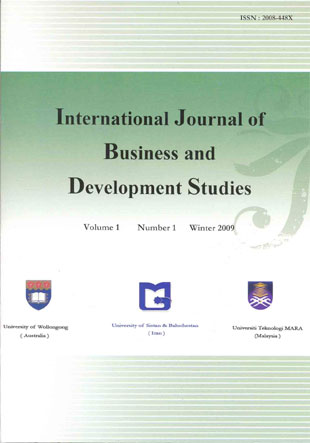فهرست مطالب

International Journal of Business and Development Studies
Volume:1 Issue: 1, Autumn 2009
- تاریخ انتشار: 1388/12/25
- تعداد عناوین: 5
-
-
Pages 51-66Negotiations among nations on policies to promote international economic integration have widened in recent years to cover new issues; for example, foreign direct investment rules, policies to promote competition, the international movement of labor, the environment and monetary union. In these negotiations, a consensus among the parties negotiating is usually lacking and many of these negotiations have stalled. Variable geometry has emerged as a possible strategy to accommodate differences in views among nations. Variable geometry may apply to either a regional agreement or a multilateral agreement. The term first appeared in documents and treaties of the European Union but it has arisen in other negotiations, particularly in the WTO where it is being discussed as a possible method of breaking through the impasse in the recent failed negotiations of the Doha Development Round of the World Trade Organization (WTO). There are other negotiating strategies which are designed to introduce flexibility in many-country negotiations in other ways. Bhagwati (1991, p. 77 and 1993, p. 45) proposed the idea of “open clubs” as a strategy for negotiating regional trade (or integration) agreements. The idea in this context is that a group of countries negotiating a regional agreement, agree as a part of these negotiations to accept subsequently any other country which wants to join the group on the same terms. This is a strategy suited to a larger group of countries among which a subset is initially willing to enter an agreement. Like variable geometry within a fixed group, it is an opt-in provision. It is variable geometry with respect to membership of the group and all of the commitments and obligations which its members have agreed to.
-
Pages 67-82
One of the basic tenets in recent international trade literature is about the effect of trade integration on business cycle synchronization (BCS) among trading countries. The objective of this paper is to explore the main determinants of business cycle synchronization، with emphasis on trade integration. To this end، we have specified two simultaneous regression equations which were estimated by weighted least squares method. The sample used data for the Organization of Islamic Countries for two consecutive periods; 1980-89 and 1990-2005. The empirical result showed that trade integration is significantly the major factor of business cycle synchronization in Islamic countries، particularly during 1990-2005 period. In addition، it was shown that similarities in both fiscal and monetary policies as well as economics structures have had considerable influence on their BCS.
-
Pages 83-98
In recent years, Risk Management in respect of Enterprise-Wide Risk Management (EWRM) has become more important and highly critical to major corporations worldwide including Malaysia. In fact, it is interesting to note that when the Government of Malaysia passed the Code of Corporate Governance in the year 2000, most of the Public Limited Companies (PLCs) in Malaysia was struggling to implement the Risk Management program for their respective companies. The Malaysian Code of Corporate Governance (MCCG) actually holds the Board of Directors of these companies responsible to manage risks related to their businesses. Today, it is rather convincing to note that many of these companies have gradually moved from the Traditional Risk Management (TRM) approach to an Integrated Risk Management approach namely, Enterprise-Wide Risk Management (EWRM). The main objectives of this scholarly study are two-fold: (a) to examine the extent of EWRM practices by these PLCs and (b) to examine how EWRM could possibly enhance the overall economic value of these companies. This particular study incorporated an industry survey which included personal interviews with the Risk Managers or Chief Risk Officers (CROs) of twenty (20) PLCs under the Malaysian Bourse (previously known as the Kuala Lumpur Stock Exchange). These companies were selected based on the extensiveness of EWRM program undertaken. It must be mentioned that this study is the first study of its kind in Malaysia. Thus, the findings would undoubtedly provide an important insight into the EWRM practices within the industry concerned in terms of how EWRM actually contributed to the overall enhancement of economic value within the business enterprises of Malaysia
-
Pages 99-112
One of the specific aspects of our time is the existence of World Trade Organization as an important international center. This organization regulates the commercial laws among the countries، and tries to provide a suitable environment for trade by eliminating the subsidies using protection policies and making a better condition for competition. In order to achieve this objective، the economic sectors of countries should move towards the production of commodities which show the comparative advantages. In order to analyze the economic potential of Iran، those fields which have comparative advantage should be recognized. One of the driving factors of comparative advantage for the Iranian petrochemical industry is oil and gas resources availability. In this research، the competitive capability، comparative advantage، as well as protection policies of selected petrochemical productions are analyzed by using Policy Analysis Matrix (PAM method).
-
Pages 113-140This paper aims to investigate the role of each aggregate spending component in the monetary policy transmission in Indonesia. It assesses the relative strength of the role of each spending component in the monetary policy transmission. In so doing, this study employs the contribution analysis, which is calculated based on the cumulative impulse response of each component of GDP to a monetary policy tightening shock estimated from structural vector autoregressive (SVAR) models. This paper finds that on average consumption spending plays predominant role in the monetary policy transmission. JEL classification numbers: C12, C22, C52 Key words: monetary policy, transmission mechanism, output composition channel, vector autoregression.

